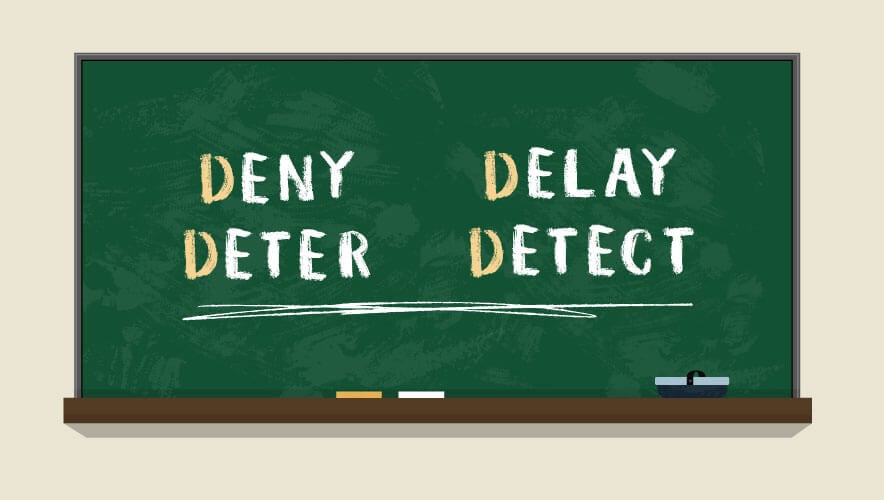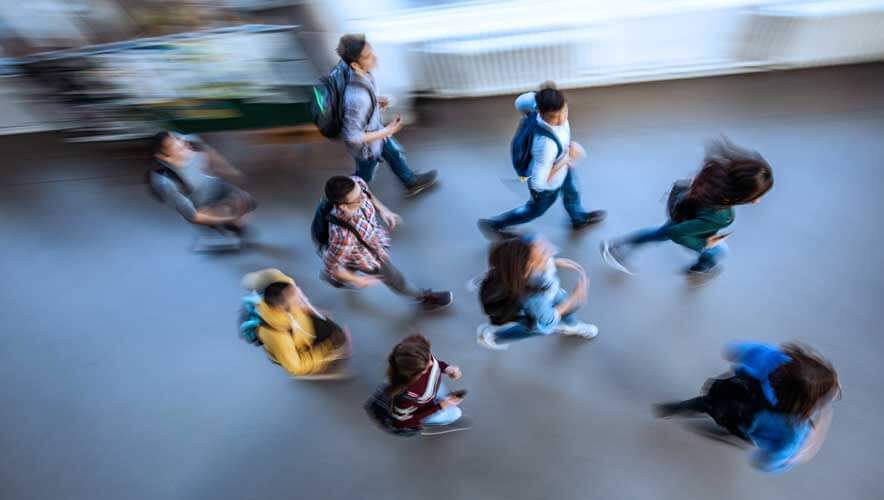Navigating the Challenges of K-12 Safety with Technology and Design
Each day, more than 56 million children attend K-12 schools in the United States. These educational institutions play a pivotal role in laying the groundwork for students' future educational and career aspirations while fostering lifelong social and emotional skills. In addition, schools are grappling with a dynamic array of security threats and challenges, often with limited resources and expertise. They must navigate the delicate balance between ensuring safety, effective learning, managing operations, and culture.
Even in the ever-changing world that we live in, the fundamentals of security design do not change. The Four D’s—deter, detect, delay, and deny—can be applied to all types of facilities, especially K-12 schools. When security design harmonizes with architectural interventions, we can proactively enhance safety and positively impact a student's educational experience.
Arguably, detect stands out as the most crucial security fundamental in the school environment. Positioned between deter and delay, it signifies that the potential threat has moved past the school's deterrence—where motivation outweighs the fear of anticipated consequences—and is moving toward actions that will assist with a bad act. The earlier the detection occurs, the broader the response, because deploying resources takes time.
Detection could be as simple as a teacher noticing something abnormal out his or her classroom window and making a call to the main office for further investigation. An example of using technology for detection would be door position switches on all exterior openings. If any doors are opened without authorization, such as a current student allowing non-students entry or leaving a door unmonitored or held open for air movement in the gym, a proper and swift response is conducted.
Not all threats are external or warrant a full response, though. Some threats are internal, including registered students who come to school with no ill intent but initiate an altercation with another student. These types of activities typically happen in non-monitored areas; students know their environment very well. Such disruptions are hard to detect because most current security systems lack the capability to identify internal threats, so officials can only monitor them through video surveillance.
Recently, in response to the evolving threat landscape for educational facilities, security technology has evolved at an exponential rate. A lot of new technologies are on the market at various levels of development, including bleeding edge, cutting edge, and proven. It is important to rely on proven technologies with a deployment history of five years or more, fully vet the cutting-edge technologies with three to five years of deployment, and be aware of bleeding-edge technologies with less than three years of deployment.
One emerging technology going from bleeding edge to cutting edge is environmental monitors. These are multi-sensor devices that are deployed throughout the school property as needed, internal and external. Environmental monitors have the capability to detect sounds, lights, motion, and odors. More importantly, they can learn about the environment and alert any abnormalities. Furthermore, they can detect elevated voices, specific words (such as profanity) that often precede an altercation, vape or THC (which are banned on school grounds), and gunshots. All of these can be handled with one physical sensor.
Additionally, it should be noted that human nature is quick to dismiss environmental variables—most commonly loud bangs. Most schools have a shop or mechanical class that often makes loud noises that transcend through the halls. As seen in recent K-12 security events, including the shootings in Parkland, Florida, and Uvalde, Texas, teachers dismissed interior gunshots as sounds associated with normal shop class activities. It is human nature to dismiss an actual security event, aligning with the philosophy that “Everything is always fine here.” Deploying this proven technology removes the probability of human error or improper identification. The sensors utilize acoustic sensing technology and sound an alarm with any matches to gunshots, removing the human-decision element and helping reduce the response time of first responders.
As with any technology, proper deployment is crucial in being used as a valuable tool in the school's security system portfolio. Some items to discuss prior to deployment are:
- Ownership. What department at the school will assume ownership of the technology and all its components? Typically, it’s the security department, but that’s not always the case.
- Maintenance. Technology will degrade over time without proper maintenance. With detection technology, periodic sensor cleaning is paramount for a highly accountable system.
- Policies and procedures. With any new technology being deployed, new policies and procedures need to be created, and existing policies need to be reviewed and adjusted. A proper response plan needs to be developed with all school stakeholders.
- Training. All personnel using, servicing, or responding to the technology needs to be properly trained.
Overall accountability of the technology needs to be high on the priority list. Simply funding and installing a new technology while instinctively relying on it as a crucial component of maintaining a safe school never works.
Building Design
To round out the Four D's approach to security, we also look at ways to design the building to inherently deter potential threats.
The employment of natural surveillance contributes significantly to the deter methodology. Building occupants who are aware they can be seen behave better. The use of windows and transparency between adult-occupied spaces—such as offices and work rooms—and corridors provides a reminder to students and visitors in common areas that they are still observed. Similarly, windows are employed at the main points of entry to monitor the approach to the building. Renovations should consider the addition of windows facing parking and arrival points as well as transaction windows in vestibules. Windows can be added from administrative areas to common areas such as lobbies and corridors to aid in the passive surveillance of these spaces.
At access points to the building, close approach by an unauthorized vehicle can be deterred with thoughtful placement of bollards or granite benches. At a recent project, a local sculptor designed welcoming benches that also prevented direct access to the main entrance by a vehicle. Although serving an important role in building security, they are generally seen as attractive additions to the front of the building and highlight the main entry.
Bullying and other bad behavior often occur in areas of perceived isolation, such as stairwells and bathrooms. Cameras outside these areas supplement natural surveillance, reminding offenders that they can be identified after the fact.
We also look for opportunities to provide open stairs where possible and have looked at alternative solutions for bathrooms to minimize unmonitored spaces. At a recent school, the sinks were relocated to the corridor side of the multiuser bathrooms. Tiled alcoves with floor drains were provided for maintenance, and a habitually problematic area was addressed by making it more visible. Rather than repeatedly reviewing surveillance footage to catch offenders, this design change prevented the events from taking place.
Holistic and Proactive Approach
In navigating the intricate landscape of K-12 school security, the principles of deter, detect, delay, and deny stand resilient. From the simplicity of a teacher's watchful eye to advanced technologies like environmental monitors, detection mechanisms play a crucial role in maintaining a secure educational environment. However, the implementation of such technologies requires thoughtful consideration to ensure their effectiveness. Moreover, in implementing these principles, architectural interventions can serve as powerful deterrents. As we adapt to the ever-changing threat landscape, a holistic and proactive approach that integrates technology and design will undoubtedly enhance the safety and well-being of our students and educators.
Kathryn Cogan, LEED AP BD+C, is education studio leader at CHA Consulting, Inc. (CHA). Cogan has provided project leadership through all phases of education planning, design, and construction for various school types and sizes, including new construction and significant renovations. Contact her at [email protected].
Toby Heath, CPP, PSP, LEED Green Associate, is life safety and security manager at CHA Consulting, Inc. He oversees CHA's life safety and security team, performing vulnerability/risk assessments and security system design and consulting, including access control, video surveillance, intrusion detection, and mass notification. Heath’s experience ranges from his real-world missions with the U.S. Army to designing all levels of security systems as a security engineer for more than 20 years. Contact him at [email protected].

















